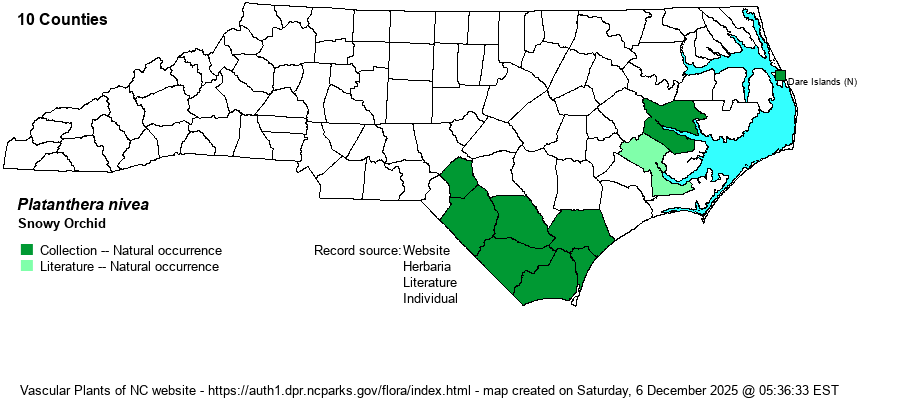| Author | (Nuttall) Luer | |
| Distribution | The range in the state is/was primarily the southern portion of the Coastal Plain, from Hoke and Robeson counties east to Pender County. A few records in the east-central Coastal Plain counties, north to Roanoke Island in Dare County. Sadly, there are probably no collections in the 21st Century (the date is hidden in SERNEC), nor any NC photos on iNaturalist. Thus, it seems to be extirpated from the state.
This is a Southern species, ranging from eastern NC south to southern FL and west to eastern TX, nearly restricted to the Coastal Plain. It is/was disjunct to southern NJ and DE, and also to a few counties in central TN, eastern AR. An unusual occurrence is in the upper Piedmont of western SC. | |
| Abundance | This is one of the saddest conservation stories in NC. This species has been recorded at least 17 times (NC NHP database records), and from at least 10 counties. Sadly, it has not been seen since the 1990's and the NC NHP has moved the state rank from S1 to SH (historical) in the last few years. One website editor (LeGrand) was fortunately to see a moderate colony in bloom in Pender County in the 1980s. Weakley (2018) states that "This species is even more irregular than most Platanthera in its flowering, whole populations sometimes not flowering for a number of years." As a result, there is still hope that it can be rediscovered in the state, especially at savanna sites that have been long fire-suppressed (if burning is re-started). This is a State Endangered species, upgraded from State Threatened in May 2021. And, in 2022 NatureServe upgraded its Global Rank from G5 to a much more concerning G3G4. | |
| Habitat | This species is/was restricted to wet savannas, and similar habitat in powerline clearings. A few populations were in wet clay-based bays but still in a "cypress savanna" habitat instead of a Longleaf Pine (P. palustris) one. |
| Phenology | This species blooms earlier than most other savanna-based Platanthera in the state, with the Fourth of July being the peak of bloom historically (such as at the Big Savanna in Pender County). Thus, it blooms from May into September, but July is the main month of flowering; it fruits shortly after flowering. | |
| Identification | When in bloom, this species has some of the, if not the, most intensely white flowers of any species in the state. It grows mostly just to 1-1.5 feet tall, with a moderately dense flower cluster about 3-4 inches tall. However, the 20 or more flowers are unique in this orchid, as each one is twisted 180 degrees such that the lip is on top and the long spurs are arranged horizontally rather than vertically. The lip of each flower is not fringed. Thus, though there are two other white-flowered Platanthera species in the Coastal Plain -- P. blephariglottis and P. conspicua -- they are really not confusing species owing to their fringed lips that are hanging downward instead of pointing skyward. This species can grow in very large stands, at least now in other states. At the Big Savanna in Pender County, which was burned annually by locals way back in the early decades of the 20th Century, extensive acres were brilliantly white in early July with the flower clusters of this rather unique orchid. [The savanna, sadly, was plowed and turned into a blueberry farm by the middle of the century, though at least we still have a few photos of the spectacle in B.W. Wells' The Natural Gardens of North Carolina (1932).] | |
| Taxonomic Comments | None, other than being named as Habenaria nivea many decades ago.
| |
| Other Common Name(s) | Bog-spice, Bog-torch | |
| State Rank | SH | |
| Global Rank | G3G4 | |
| State Status | E | |
| US Status | | |
| USACE-agcp | FACW link |
| USACE-emp | FACW link |

